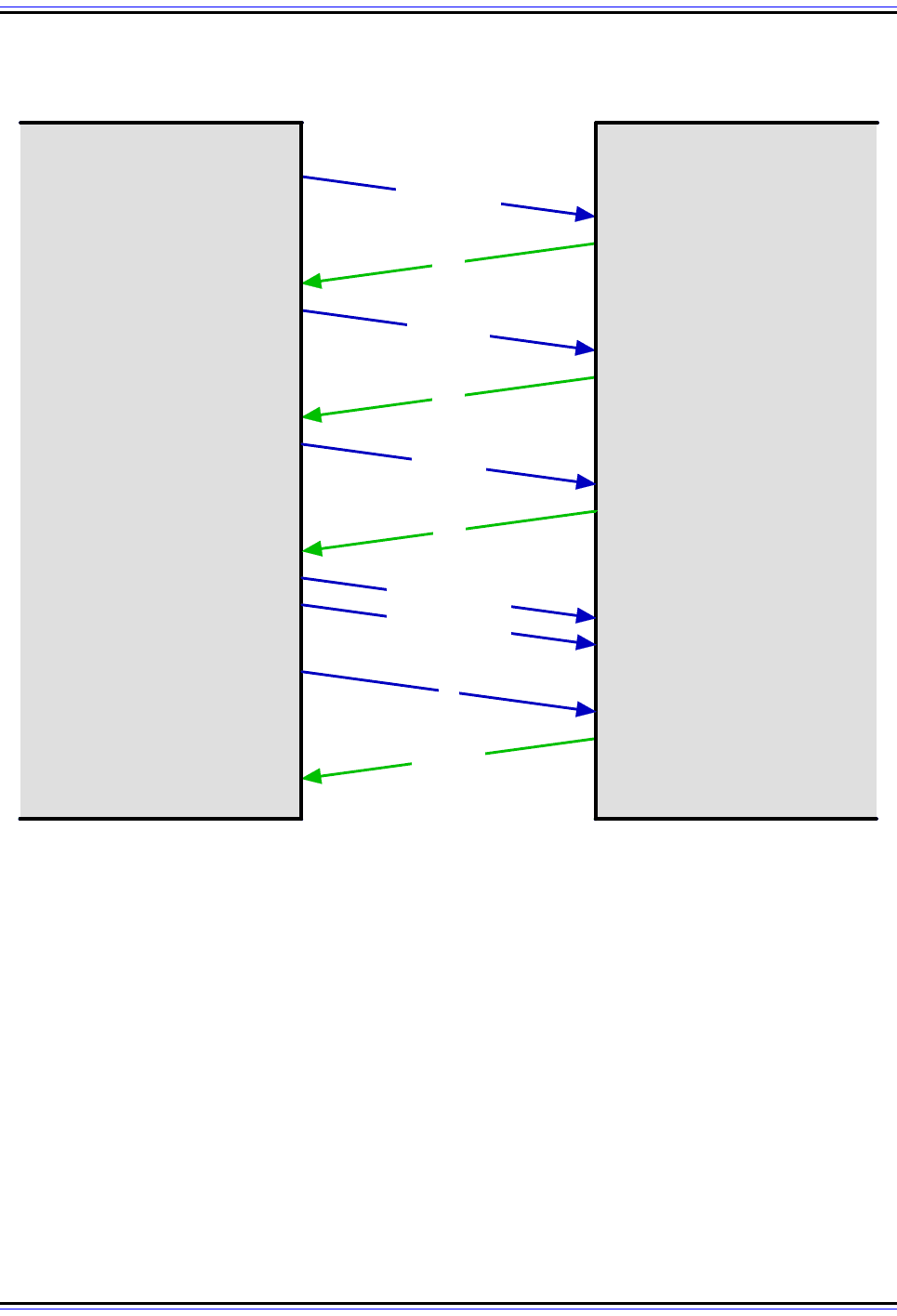Charles M. Kozierok The TCP-IP Guide
Подождите немного. Документ загружается.


The TCP/IP Guide - Version 3.0 (Contents) ` 1431 _ © 2001-2005 Charles M. Kozierok. All Rights Reserved.
☯ Specifying the sender and recipients separately is more efficient, as it gives the SMTP
receiver the information it needs “up front” before the message itself is transmitted. In
fact, the SMTP receiver can decide whether or not to accept the message based on
the source and destination e-mail addresses.
☯ Having this information specified separately gives greater control on how e-mail is
distributed. For example, an e-mail message may be addressed to two recipients, but
they may be on totally different systems; the SMTP sender might wish to deliver the
mail using two separate SMTP sessions to two different SMTP receivers.
☯ In a similar vein, there is the matter of delivering blind carbon copies. Someone who is
“BCC'ed” on a message must receive it without being mentioned in the message itself.
☯ Having this information separate makes implementing security on SMTP much easier.
For these reasons, SMTP draws a distinction between the message itself, which it calls the
content, and the sender and recipient identification, which it calls the envelope. This is of
course consistent with our running analogy between regular mail and e-mail. Just as the
postal service delivers a piece of mail using only the information written on the envelope,
SMTP delivers e-mail using the envelope information and not the content of the message.
It's not quite the case that the SMTP server doesn't look at the message itself, just that this
is not the information it uses to manage delivery.
Note: It is possible for the sender of a message to generate envelope information
based on the contents of the message, but this is somewhat “external” to SMTP
itself. It is described in the standard but caution is urged in exactly how this is
implemented.
SMTP Mail Transaction Details
Let’s take a more detailed look at the SMTP mail transaction process, using as aids the
process diagram in Figure 305 and the example transaction of Table 251 (which has
commands highlighted in bold and replies in italics). The first two steps in the mail trans-
action are responsible for providing the receiving SMTP server with the envelope
information just discussed. The transaction begins by the SMTP sender issuing a MAIL
command. This serves to inform the receiver that a new transaction is commencing, and
also to tell it the “from” information on the “envelope”. An example:
MAIL FROM:<joe@someplace.org>
The e-mail address of the originator is always enclosed in angle brackets (“<”and “>”). The
SMTP receiver acknowledges the command with a 250 (“OK”) reply message, sometimes
sending back the address as a confirmation. For example:
250 <joe@someplace.org>… Sender ok

The TCP/IP Guide - Version 3.0 (Contents) ` 1432 _ © 2001-2005 Charles M. Kozierok. All Rights Reserved.
Next, the SMTP sender uses RCPT commands to specify the intended recipients of the e-
mail that is being sent. Each RCPT line can contain only one recipient, so if multiple recip-
ients are indicated, two or more RCPT commands must be issued. Each one normally
specifies an e-mail address, but if relaying is being used, the command may contain routing
information as well. (As described in the SMTP communication topic, this is not as
commonly done as it was in the past.) For example:
RCPT TO:<jane@somewhereelse.com>
Figure 305: SMTP Mail Transaction Process
Once an SMTP session is established between a sender and receiver, each mail transaction consists of a set
of three command/reply sequences. The sender is first identified using the MAIL command and the recipients
are specified using one or more RCPT commands. The actual mail message is then transferred using the
DATA command, which involves a preliminary reply before the actual message is sent, and a completion reply
when it has been fully received.
SMTP ReceiverSMTP Sender
MAIL FROM
1. Begin Transaction:
Identify Sender
Using MAIL Command
2. Receive MAIL; Begin New
Transaction, Send 250 "OK"
4. Receive RCPT;
Send 250 "OK" Reply
3. Receive "OK" Reply;
Identify Recipient
Using RCPT Command
250
RCPT TO
5. Receive "OK" Reply;
Begin Data Transfer
Using DATA Command
250
Send "." By Itself To Indicate
End of E-Mail Message Body
250
8. Receive and Store E-Mail
Message Lines
9. Receive "OK" Reply; Mail
Transaction Complete
DATA
6. Receive DATA;
Send 354 Intermediate Reply
354
7. Receive Intermediate
Reply; Send E-Mail Message
Headers and Body
(message line)
(message line)
"
.
"
...
...
Receive "."; Store E-Mail
Message, Send 250 "OK" Reply
...

The TCP/IP Guide - Version 3.0 (Contents) ` 1433 _ © 2001-2005 Charles M. Kozierok. All Rights Reserved.
Assuming the server accepts the e-mail, it will give a 250 “OK” reply again, such as this:
250 <jane@somewhereelse.com>… Recipient ok
The SMTP sender then issues the DATA command, which tells the SMTP receiver that the
message is coming:
DATA
The SMTP receiver responds with a 354 “intermediate” reply message, such as this:
354 Enter mail, end with “.” on a line by itself
The SMTP sender then sends the e-mail message, one line at a time, with a single “.” on a
line to terminate it. The server confirms the receipt of the message with another 250 “OK”
reply, and the transaction is done.
Key Concept: After an SMTP session is established, e-mail messages are sent
using the SMTP mail transaction process. The SMTP sender starts the transaction
by identifying the sender of the e-mail, and then specifying one or more recipients.
The e-mail message itself is then transmitted to the SMTP receiver. Each e-mail to be sent
is a separate transaction.
Table 251: Example SMTP Mail Transaction
MAIL FROM:<joe@someplace.org>
250 <joe@someplace.org>… Sender ok
RCPT TO:<jane@somewhereelse.com>
250 <jane@somewhereelse.com>… Recipient ok
DATA
354 Enter mail, end with "." on a line by itself
From: Joe Sender <joe@someplace.org>
To: Jane Receiver <jane@somewhereelse.com>
Date: Sun, 1 Jun 2003 14:17:31 —0800
Subject: Lunch tomorrow
Hey Jane,
It's my turn for lunch tomorrow. I was thinking we could
[rest of message]
Hope you are free. Send me a reply back when you get a chance.
Joe.
.
250 OK

The TCP/IP Guide - Version 3.0 (Contents) ` 1434 _ © 2001-2005 Charles M. Kozierok. All Rights Reserved.
Potential Mail Transaction Complications
While this indeed is quite simple, I should point out that I have only shown an e-mail from a
sender to one recipient, and the case where there are no problems or complications in the
transaction. Due to either command syntax or server issues, it is possible for various types
of errors to occur at different stages of the process, which may result in the transaction
failing. There are also security concerns that may come into play, that may lead to restric-
tions in what transactions a server may allow.
SMTP Special Features, Capabilities and Extensions
The primary job of the Simple Mail Transfer Protocol is of course to implement the TCP/IP
electronic mail delivery system. Whenever the user of an SMTP server gives it an e-mail
message addressed to a non-local mailbox, the server will attempt to transfer it to the
appropriate destination server, using the SMTP mail transaction process. Many billions of
such transfers are performed every day on the Internet, allowing e-mail to quickly reach its
destination anywhere around the world.
SMTP Special Features
In addition to the basic mail transfer mechanism, SMTP includes a number of other features
and capabilities. These allow SMTP to support special requirements and auxiliary needs of
the mail system, and are described in detail in RFC 2821. It would take many topics to
describe them all in detail, so I will just provide a quick summary of the more important ones
here so you know a bit about them:
☯ Mail Relaying: As discussed in the SMTP communication overview, the protocol was
once widely used in a “relaying mode” where e-mail was routed from one SMTP server
to another to reach its destination. Today, the normal method of e-mail transfer on the
Internet today is directly from the sender's SMTP server to the recipient's, using DNS
MX records to determine the recipient SMTP server address. SMTP still includes the
ability to relay mail from one server to another, provided certain conditions are met.
Note that in addition to the inefficiency of relaying, many servers won't relay mail
because this feature has been abused for spamming and hacking.
☯ Mail Forwarding: Under certain conditions, an SMTP server may agree to accept e-
mail for a non-local mailbox and forward it to the appropriate destination. This sounds
similar to relaying but is used in a different way. A common example is when a user
changes his or her e-mail address. If I have worked at XYZ Industries for years and
then retire, the company may no longer wish to let me receive e-mail at the company's
SMTP server. As a courtesy, however, they may forward e-mail sent to me there so I
still receive it at my new company.
☯ Mail Gatewaying: Certain SMTP servers may be configured as e-mail gateways.
These devices “translate” TCP/IP e-mail into a form suitable for another e-mail system,
and vice-versa. Gatewaying is a complex topic because e-mail systems can be so
different; one of the more important problems is the inconsistency of addressing
methods of different e-mail systems.
☯ Address Debugging: SMTP includes a VRFY (verify) command, which can be used
to check the validity of an e-mail address without actually sending mail to it.

The TCP/IP Guide - Version 3.0 (Contents) ` 1435 _ © 2001-2005 Charles M. Kozierok. All Rights Reserved.
☯ Mailing List Expansion: The SMTP command EXPN (expand) can be used to
determine the individual e-mail addresses associated with a mailing list. (Note
however that this has nothing directly to do with mailing list software like Majordomo.)
☯ “Turning”: The original SMTP protocol included a command that allows the SMTP
sender and SMTP receiver to change roles. This could be used to allow SMTP server
A to send e-mail to server B, and then have B send e-mail it has queued for A in the
same session. In practice, this capability was not widely used for a variety of reasons,
including security considerations. It is now officially “not recommended”, but may still
be implemented in some SMTP software.
Other Capabilities and Functions of SMTP Servers
The list above represents just a few of the features that are mentioned in the SMTP
standards. In addition to these, a given type of SMTP server software may be given other
features as well by its developers. The HELP command is one way to determine what some
of the commands that a given SMTP server supports.
SMTP servers also must perform a great deal of “background processing” that doesn't get a
great deal of attention. This includes managing connections, checking for errors in
commands and e-mail messages, and reacting accordingly. They must also be on the
lookout for problem conditions, such as “looping” that may result in an e-mail message
being passed back and forth between two SMTP servers, each thinking the other is the
intended recipient. In the event of an initial failure to deliver mail, SMTP servers are also
required to periodically retry communication with the destination device, and return a failure
message to the sender if it cannot deliver the message after a certain period of time. Again,
RFC 2821 contains more details.
SMTP Extensions
As discussed earlier in this section, during the 1990s many extensions to the basic
operation of SMTP were defined. These are enabled when two SMTP servers supporting
the extension set up a session using the EHLO command and appropriate extension
response codes. Table 252 summarizes some of the more interesting SMTP extensions
that have been defined, and gives the RFC number where each is described.
Table 252: SMTP Extensions (Page 1 of 2)
Extension
Keyword
Extension
Defining
Document
Description
8BITMIME 8-bit MIME support. RFC 1652
Theoretically defines support for the 8-bit
content transfer encoding type in MIME, but
there are complications associated with this. See
the discussion of content encoding in the MIME
section.
AUTH Authorization RFC 2554
Used to implement an authorization mechanism
for servers requiring enhanced security.

The TCP/IP Guide - Version 3.0 (Contents) ` 1436 _ © 2001-2005 Charles M. Kozierok. All Rights Reserved.
On The Web: The full current set of SMTP extensions can be found here: http://
www.iana.org/assignments/mail-parameters
Note: Certain commands in the basic SMTP protocol description that are
considered optional are also sometimes considered extensions, such as the EXPN
and HELP commands; I have not listed these here since they are not true SMTP
extensions.
SMTP Security Issues
If you've already read the sections describing other TCP/IP protocols such as DHCP, FTP
and so forth, you probably already know how I am going to start this section. The theme is a
common one in TCP/IP: a lack of security in how a protocol is implemented. And this all
goes back to a common root cause: most of these protocols were developed when the
“Internet” was just a small group of machines controlled by individuals who mostly knew
and trusted each other, or who were able to use physical security means. Developers never
imagined TCP/IP being used by millions of anonymous “average Joe” users around the
world, which necessitates far more attention to security than a small research internetwork
like the ARPAnet.
DSN
Delivery status
notification
RFC 1891
Allows an SMTP sender to request that the
SMTP receiver notify it a problem occurs in
delivering a message the sender gives to it.
ENHANCED-
STATUSCODES
Enhanced status
codes.
(They should have
abbreviated the
keyword. ☺)
RFC 2034,
RFC 1893
Extends the traditional 3-digit SMTP reply code
format with extra codes that provide more infor-
mation. See the end of the topic on SMTP
replies for more.
PIPELINING Command pipelining RFC 2920
Allows multiple commands to be transmitted in
batches from the SMTP sender to the receiver,
rather than sending one command at a time and
waiting for a response code.
SIZE
Message size
declaration
RFC 1870
Allows information about the size of a message
to be declared by an SMTP sender prior to trans-
mitting it, so the SMTP receiver can decide if it
wants the message or not.
Table 252: SMTP Extensions (Page 2 of 2)
Extension
Keyword
Extension
Defining
Document
Description

The TCP/IP Guide - Version 3.0 (Contents) ` 1437 _ © 2001-2005 Charles M. Kozierok. All Rights Reserved.
When it comes to SMTP, security matters are if anything worse than they are with the other
protocols I mentioned above. Not only does SMTP not have any real security mechanism,
the original relaying model of SMTP communication is entirely designed around the idea of
“cooperation” and “trust” between servers. Since most SMTP servers would be asked to
handle a certain number of intermediate transfers, each server was required to accept mail
from any originator to be delivered to any destination.
The basic assumption in this model is that SMTP servers would all be “well-behaved”, and
not abuse the system by flooding intermediate servers with lots of mail to be delivered, or
sending bogus messages to cause problems. This all changed as the Internet exploded in
popularity in the 1990s. Con artists, hackers, and disreputable salespeople all discovered
that e-mail could be used for “free” delivery of messages simply by submitting them to an
SMTP server for delivery. The result was overloaded servers, primarily due to the sending
of large quantities of unwanted e-mail, which Internet users commonly call spam.
Note: The term “spam”, in this context, does not have anything directly to do with
the Hormel processed meat product. Its use in reference to massive amounts of e-
mail comes from a Monty Python comedy sketch where that word is repeated over
and over again.
It is actually very easy to “impersonate” an SMTP server. You can use the Telnet Protocol to
connect directly to an SMTP server on port 25. SMTP commands are all sent as text, and
so are SMTP replies, so you can have a “conversation” with a server and even manually
perform a mail transaction. This is useful for debugging, but also makes abuse of a wide
open SMTP server trivially easy. Since spammers often don't want to be identified, they
employ spoofing techniques to make it more difficult to identify them, which makes matters
even more difficult.
Common SMTP Server Security Techniques
Despite this obvious problem, efforts to implement a general security mechanism in SMTP
have been resisted for two main reasons. First, there is no foolproof way to retrofit a new
security mechanism onto something as widely used as SMTP without creating incompatibil-
ities between newer and older systems. Second, many administrators were reluctant to
completely do away with the general notion of cooperation between sites that has helped
make the Internet so successful, simply due to a few “bad apples”.
Still, something had to be done. The compromise was for system administrators to “tighten
up” their SMTP servers through the imposition of both technical and policy changes.
Naturally, these vary from one organization to another. Some of the more common SMTP
security provisions include:
☯ Checking the IP address of a device attempting connection and refusing to even start
an SMTP session unless it is in a list of authorized client devices.

The TCP/IP Guide - Version 3.0 (Contents) ` 1438 _ © 2001-2005 Charles M. Kozierok. All Rights Reserved.
☯ Restriction of certain commands or features, such as e-mail relaying, to authorized
users or client servers. This is sometimes done by requiring authentication via the
SMTP extension AUTH before the command will be accepted.
☯ Limiting the use of commands such as EXPN to prevent unauthorized users from
determining the e-mail addresses of users on mailing lists.
☯ Checking the validity of envelope information before accepting a message for delivery.
Some servers will first verify that the originator's e-mail address is valid before
agreeing to accept the MAIL command. Many will check the recipient's address and
refuse the message if delivery is not to a local mailbox. Others use even more
advanced techniques.
☯ Limiting the size of e-mail messages that may be sent or the number that may be sent
in a given period of time.
☯ Logging all access to the server to keep records of server use and check for abuse.
Because of all the abuse in recent years, you will find that most SMTP servers implement
these or other features, even though most of those features are not formally defined by the
SMTP standards. They are instead enhancements built into individual SMTP server
software packages.
Some of these measures can actually get quite sophisticated. For example, the SMTP
server run by pair Networks, the great Web hosting company I have used for years, uses
“POP-before-SMTP authentication”. This means that before the server will accept outgoing
mail from the user via SMTP, the user must first log in to check incoming mail using the Post
Office Protocol. Since POP includes authentication, successful POP login tells the server
the user is authorized. This “flips a switch” in the server that allows the user to access the
SMTP service after that login for a limited period of time. If this seems convoluted, well, you
start to get an idea of the hassle that spammers and hackers have created for Internet
service providers today.
It's also worth noting that SMTP does not include any mechanism for encryption to ensure
the privacy of e-mail transmissions. Users requiring security in who sees their messages
must use a separate encryption scheme to encode the body of the message prior to
submission.
Key Concept: SMTP was designed in an era where internet security was not much
of an issue; as a result, the base protocol includes no security mechanism at all.
Since e-mail is so often abused today, most modern SMTP servers incorporate one
or more security features to avoid problems.

The TCP/IP Guide - Version 3.0 (Contents) ` 1439 _ © 2001-2005 Charles M. Kozierok. All Rights Reserved.
SMTP Commands
I mentioned in the overview and history of SMTP that early TCP/IP e-mail mechanisms
were developed by borrowing techniques and elements from existing application protocols,
especially Telne t and FTP. SMTP is an independent protocol, but its heritage can still be
seen clearly in a few areas. One of the more obvious of these is in the method by which
commands are issued by an SMTP sender and replies returned by an SMTP receiver.
Like FTP, all SMTP commands are sent as plain ASCII text over the TCP connection estab-
lished between the client and server in an SMTP connection. These commands must end
with the two-character “CRLF” sequence that normally terminates ASCII text as required for
the Telnet Network Virtual Terminal (NVT). In fact, you can check the function of an SMTP
server and even issue commands to it yourself, simply by using Telnet to connect to it on
port 25.
SMTP Command Syntax
All SMTP commands are specified using a four-letter command code. Some commands
also either allow or require parameters to be specified. The basic syntax of a command is:
<command-code> <parameters>
When parameters are used, they follow the command code and are separated from it by
one or more space characters. For example, the HELO and EHLO commands are specified
with the command code, a space character, and then the domain name of the SMTP
sender, as we saw in our look at SMTP connection establishment.
Current SMTP Commands
Table 253 lists the commands currently used in modern SMTP, in the order they are
described in RFC 2821, with a brief description of each.
Table 253: SMTP Commands (Page 1 of 2)
Command
Code
Command Parameters Description
HELO Hello
The domain name of the
sender.
The conventional instruction sent by an SMTP
sender to an SMTP receiver to initiate the SMTP
session.
EHLO
Extended
Hello
The domain name of the
sender.
Sent by an SMTP sender that supports SMTP
extensions to greet an SMTP receiver and ask it
to return a list of SMTP extensions the receiver
supports. The domain name of the sender is
supplied as a parameter.

The TCP/IP Guide - Version 3.0 (Contents) ` 1440 _ © 2001-2005 Charles M. Kozierok. All Rights Reserved.
Like FTP commands, SMTP commands are not case sensitive.
Certain SMTP extensions make changes to the basic SMTP command set. For example,
the AUTH extension specifies a new command (also called AUTH) that specifies an authen-
tication method the SMTP client wants to use. Other extensions define new parameters for
existing commands. For example, the SIZE extension defines a SIZE parameter that can be
added to a MAIL command to tell the SMTP receiver the size of the message to be
transferred.
MAIL
Initiate Mail
Transaction
Must include a “FROM:”
parameter specifying the
originator of the
message, and may
contain other parameters
as well.
Begins a mail transaction from the sender to the
receiver.
RCPT Recipient
Must include a “TO:”
parameter specifying the
recipient mailbox, and
may also incorporate
other optional
parameters.
Specifies one recipient of the e-mail message
being conveyed in the current transaction.
DATA
Mail Message
Data
None
Tells the SMTP receiver that the SMTP sender is
ready to transmit the e-mail message. The
receiver normally replies with an intermediate
“go ahead” message, and the sender then
transmits the message one line at a time,
indicating the end of the message by a single
period on a line by itself.
RSET Reset None
Aborts a mail transaction in progress. This may
be used if an error is received upon issuing a
MAIL or RCPT command, if the SMTP sender
cannot continue the transfer as a result.
VRFY Verify
E-mail address of mailbox
to be verified.
Asks the SMTP receiver to verify the validity of a
mailbox.
EXPN Expand
E-mail address of mailing
list.
Requests that the SMTP server confirm that the
address specifies a mailing list, and return a list
of the addresses on the list.
HELP Help Optional command name.
Requests help information: general help if no
parameter is supplied, otherwise information
specific to the command code supplied.
NOOP No Operation None
Does nothing except for verifying communication
with the SMTP receiver.
QUIT Quit None Terminates the SMTP session.
Table 253: SMTP Commands (Page 2 of 2)
Command
Code
Command Parameters Description
